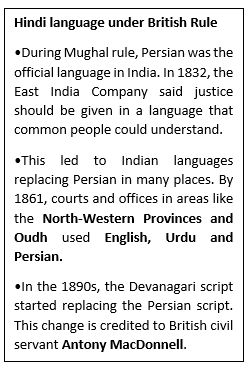Syllabus
GS 1: Salient features of Indian Society, Diversity of India
Context:
The recent debate on language issues makes it important to look back at the Nagari Pracharini Sabha which played a key role in getting Hindi officially recognised.
Recent language conflict:
- Politics around Hindi and its “imposition“ is rising again in Maharashtra.
- Uddhav and Raj Thackeray have united to support Marathi language rights after the state government withdrew its decision to make Hindi the default third language in primary schools.
- Tamil Nadu Chief Minister MK Stalin also reacted by saying that BJP was forced to take back the decision in Maharashtra because of public opposition.
Foundation of Nagari Pracharini Sabha

- In 1888, Maharaja Lakshmeshwar Singh of Darbhanga made Hindi an official language in his region, inspired by the slogan “Hindi, Hindu, Hindustan”.
- The Nagari Pracharini Sabha was founded on January 16, 1893 by Shyam Sunder Das, Pandit Ramnarayan Mishra and Thakur Shivkumar Singh to promote Hindi in courts and offices.
- The Sabha also decided to create a proper Hindi dictionary. From 1908, the Sabha sent people across villages and towns to collect words and their meanings for this dictionary.
- After 21 years of work, in 1929, the Sabha published the 11-volume Hindi dictionary “Shabd Sagar”, with forewords by Acharya Ramchandra Shukla and Shyam Sunder Das.
- Acharya Shukla’s “History of Hindi Literature”, published by the Sabha and became a key book for understanding Hindi literature.
- In 1896, the Arya Bhasha Pustakalaya, the largest Hindi library, at that time, was established.
- Even though English, Urdu, and Persian were dominant then, the Sabha worked hard to promote Hindi, gaining support from leaders like Bal Gangadhar Tilak, even though it remained apolitical.
Hindi After Independence
- After independence, Pandit Jawaharlal Nehru became a patron of the Nagari Pracharini Sabha.
- The Nagari Pracharini Patrika, India’s oldest Hindi research journal, has been published since 1896.
- The famous Hindi magazine Saraswati, edited by Pandit Mahavir Prasad Dwivedi, started in 1900 under the Sabha’s support.
- The Sabha was first based in Banaras, and later expanded to Haridwar and New Delhi. In Haridwar, Swami Satyadev Parivrajak donated land for its building.
- The Hindi movement grew, and local branches of the Sabha were started in many towns. From the 1970s, the Sabha’s work slowed down as politics influenced language and literature.
- A leadership dispute over the Sabha reached the Allahabad High Court, which ruled in February last year in favour of Vyomesh Shukla’s group.
- Under new leadership, the Sabha reprinted Acharya Ramchandra Shukla’s History of Hindi Literature and published Hindi poems by Amir Khusrau.
Mains Question
Discuss the historical role of the Nagari Pracharini Sabha in the promotion and standardization of the Hindi language. How has the organisation’s journey reflected the larger politics of language in post-independence India? (15M, 250W)

